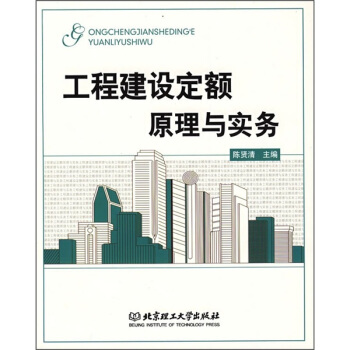

具体描述
内容简介
This textbook is intended for use in a first course in mechanics of materials. Programs of instruction relating to the mechanical sciences, such as mechanical, civil, and aerospace engineering, often require that students take this course in the second or third year of studies. Because of the fundamental nature of the subject matter, mechanics of materials is often a required course, or an acceptable technical elective in many other curricula. Students must have completed courses in statics of rigid bodies and mathematics through integral calculus as prerequisites to the study of mechanics of materials.目录
CHAPTER 1 StressCHAPTER 2 Strain
CHAPTER 3 Torsion
CHAPTER 4 Shear and Moment in Beams
CHAPTER 5 Stresses in Beams
CHAPTER 6 Deflection of Beams
CHAPTER 8 Stresses Due to Combined Loads
CHAPTER 9 Composite Beams
CHAPTER 10 Columns
CHAPTER 11 Additional Beam Topics
CHAPTER 12 Special Topics
CHAPTER 13 Inelastic Action
精彩书摘
If two bodies are pressed against each other, compressive forces are devel-oped on the area of contact. The pressure caused by these surface loads iscalled bearing stress. Examples of bearing stress are the soil pressure beneatha pier and the contact pressure between a rivet and the side of its hole. If thebearing stress is large enough, it can locally crush the material, which in turncan lead to more serious problems. In order to reduce bearing stresses, en-gineers sometimes employ bearing plates, the purpose of which is to distributethe contact forces over a larger area.As an illustration of bearing stress, consider the lap joint formed by thetwo plates that are riveted together as shownin Fig. 1.12(a). The bearingstress caused by the rivet is not constant; it actually varies from zero at thesides of the hole to a maximum behind the rivet as illustrated in Fig. 1.12(b).The difficulty inherent in such a complicated stress distribution is avoided bythe common practice of assuming that the bearing stress ab is uniformlydistributed over a reduced area.
……
前言/序言
This textbook is intended for use in a first course in mechanics of materials.Programs of instruction relating to the mechanical sciences, such as me-chanical, civil, and aerospace engineering, often require that students takethis course in the second or third year of studies. Because of the fundamentalnature of the subject matter, mechanics of materials is often a requiredcourse, or an acceptable technical elective in many other curricula. Studentsmust have completed courses in statics of rigid bodies and mathematicsthrough integral calculus as prerequisites to the study of mechanics ofmaterials.To place this book in context for engineering education, the user shouldknow that it is an extensive revision of the fourth edition of Strength ofMaterials by Pytel and Singer. The contents have been thoroughly modern-ized to reflect the realities and trends in contemporary engineering educa-tion. In addition to eliminating a few of the specialized topics normallytaught in more advanced civil engineering courses, the coverage of funda-mental topics has been expanded. All of the illustrations have been redrawnand improved, with the addition of a second color for clarity and as an aidto understanding complex structures. Many new diagrams aid the visualiza-tion of concepts and improve the comprehension of derivations. Fully 60%of the homework problems are new or modified versions of previous prob-lems. A new feature is the computer problems found at the end of eachchapter.
Every effort has been made to maintain the conciseness and organiza-tion that were the hallmarks of the earlier editions of Pytel and Singer. In thefirst eight chapters, emphasis is placed exclusively on elastic analysis throughthe presentation of stress, strain, torsion, bending, and combined loading.An instructor can easily teach these topics within the time constraints of atwo- or three-credit course. The remaining five chapters of the text covermaterial that can be omitted from an introductory course. Because thesemore advanced topics are not interwoven in the early chapters on the basictheory, the core material can efficiently be taught without skipping overtopics within chapters. Once the instructor has covered the material on elas-tic analysis, he or she can freely choose topics from the more advanced laterchapters, as time permits. Organizing the material in this manner has createda significant savings in the number of pages without sacrificing topics thatare usually found in an introductory text.
用户评价
这本书给我带来的,不仅仅是知识的传授,更是一种学习的启迪。它以一种非常独特且有效的方式,让我对材料力学这门学科产生了前所未有的兴趣。 作者在编写过程中,显然是下了苦功。他将一些原本晦涩难懂的力学概念,用非常生动形象的语言进行解释。我常常在阅读时,感觉就像是在听一位经验丰富的工程师在给我讲解,而不是在看一本枯燥的教科书。 书中对公式的推导过程,我只能用“尽善尽美”来形容。作者会详细地展示每一步的推导过程,并且会对每一步的逻辑关系进行详细的解释。这让我彻底告别了“死记硬背”的时代,而是能够真正地理解公式背后的原理。 书中的插图和图示,是我学习过程中最得力的助手。那些生动而精确的图示,能够帮助我理解那些抽象的力学概念。我经常会一边看书,一边对照图示,那些原本难以想象的力学现象,在图示的帮助下,变得清晰可见。 我尤其要表扬书中例题的设计。它们不仅覆盖了重要的知识点,而且难度设置也比较合理,从易到难,逐步递进。更重要的是,每道例题都提供了非常详细的解题步骤和思路分析。我经常会自己先尝试解答,然后再对照书中的解析,从中学习不同的解题技巧和思维方式。 光盘的附赠,是这本书最让我感到意外的惊喜之一。那些演示动画,将原本抽象的力学过程,生动地展现在我眼前。我曾经花费大量时间去观看关于材料屈曲、断裂过程的动画,这些直观的展示,让我对这些力学现象有了更深刻的认识。 这本书的语言风格非常适合学生阅读。作者用清晰、流畅的语言进行表达,并且在一些地方还会穿插一些有趣的工程案例,让我能够更好地理解理论在实际中的应用。 我认为这本书最成功的地方在于,它能够将理论知识与工程实践紧密地结合起来。书中不仅仅是讲解理论,更是时刻提醒读者,这些理论在实际工程设计中是如何发挥作用的。 从一个希望扎实掌握材料力学知识的学生角度来看,这本书的深度是足够的。它不仅仅是停留在概念的介绍,而是深入到了理论的本质,让我能够真正地理解材料力学的核心思想。 这本书的排版和印刷质量也是一流的。纸张的质感很好,印刷清晰,文字大小适中,阅读起来非常舒适,不会有视觉疲劳感。而且,书中的目录和索引设计也非常合理,方便我快速查找所需的知识点。 总而言之,这是一本我强烈推荐给所有材料力学学习者的经典教材。它不仅为我打下了坚实的材料力学基础,还激发了我对工程领域的兴趣。
评分这本书的厚重感,不仅仅体现在它的物理体积上,更体现在其内容的深度和广度上。拿到这本书的瞬间,我就能感受到它蕴含的知识分量。作者在编写过程中,显然是倾注了巨大的心血,力求将材料力学这一门复杂而重要的学科,以一种系统、完整的方式呈现给读者。 我特别欣赏作者在引入新概念时所采用的“循序渐进”的教学方法。他不会一开始就抛出过于复杂的公式和理论,而是会从一些基本的生活现象或者简单的工程问题出发,引导读者逐步思考,然后自然而然地引入相关的力学原理。这种“由浅入深”的学习方式,极大地降低了学习门槛,也让我更容易理解和接受那些抽象的理论。 书中对公式的推导过程,可以说是“事无巨细”。我曾经因为某个公式的推导过程过于“跳跃”而感到困扰,但在这本书中,我完全不用担心这个问题。作者会非常详细地展示每一个推导步骤,并且会解释为什么这样做,以及每一步的依据是什么。这让我不仅学会了如何应用公式,更理解了公式背后的逻辑和推导思路。 书中的插图和图示,简直是我学习过程中的“好帮手”。很多抽象的力学概念,比如应力状态、应变张量等,单靠文字描述是很难理解的。但是,书中那些精确、清晰的图示,能够直观地展示出这些概念的物理意义。我经常会在阅读时,一边看文字,一边对照图示,这样一来,很多原本模糊的概念就变得清晰起来。 我特别喜欢书中提供的例题。它们不仅数量多,而且涵盖了材料力学中几乎所有的重点和难点。更难能可贵的是,每道例题的解答都非常详尽,不仅给出了最终答案,还详细分析了求解的思路和关键步骤。我经常会自己先做一遍,然后再对照答案,从中学习不同的解题技巧和思路。 光盘的附赠,更是让这本书的价值倍增。我曾经对很多力学现象只有概念上的理解,而无法直观感受。但是,光盘中的演示动画,将这些抽象的力学过程生动地展现在我面前。例如,材料在不同载荷下的变形过程、应力集中的区域等等,通过动态的视觉呈现,让我对这些现象有了更深刻的认识。 这本书的语言风格也值得称赞。作者在保证学术严谨性的同时,并没有使用过于生僻的词汇。他的语言表达清晰、流畅,逻辑性强,让我在阅读过程中不会感到晦涩。而且,书中在一些地方还会穿插一些有趣的工程案例,让我能够更好地理解理论在实际中的应用。 我认为这本书最成功的地方之一,就是它能够将纯粹的理论知识与实际工程应用紧密地结合起来。书中不仅仅是讲解理论,更是时刻提醒读者,这些理论在实际工程设计中是如何发挥作用的。例如,在讲解材料的强度时,书中会详细介绍如何根据工程需求选择合适的材料,并进行许用应力的计算。 从一个希望在材料力学领域有所建树的学生角度来看,这本书的深度是远远超出我预期的。它不仅仅是停留在概念的介绍,而是深入到了理论的本质,让我能够真正地理解材料力学的核心思想。 这本书的纸张质量、印刷排版都堪称一流。书本拿在手里很有质感,阅读体验非常舒适。而且,目录和索引的设计也非常合理,方便我快速查找所需的知识点。 总而言之,这是一本我强烈推荐给所有材料力学学习者的经典教材。它不仅仅是一本学习工具,更像是一位经验丰富的导师,能够带领我深入探索材料力学的奥秘,并为我未来的学习和工作打下坚实的基础。
评分这本书的出现,对于我这个初涉材料力学领域的学生来说,简直是一场“及时雨”。它以一种近乎“无微不至”的关怀,引导我逐步走进这门看似复杂的学科。 作者在编写过程中,显然是充分考虑到了读者的学习体验。他将复杂的力学概念,分解成一个个小的、易于理解的单元,并且在每个单元的开头,都设置了生动的引入语,让我能够带着问题去学习。这种“引导式”的学习方式,极大地激发了我的学习兴趣。 书中对公式的推导过程,我只能用“详尽”二字来形容。作者不仅仅是给出了推导过程,还会对每一步的逻辑关系进行详细的解释,并且会分析每一步推导的物理意义。这让我彻底告别了“死记硬背”的时代,而是能够真正地理解公式背后的原理。 书中的插图和图示,是我学习过程中最忠实的伙伴。那些生动而精确的图示,能够帮助我理解那些抽象的力学概念。我经常会一边看书,一边对照图示,那些原本难以想象的力学现象,在图示的帮助下,变得清晰可见。 我尤其要表扬书中例题的设计。它们不仅仅覆盖了重要的知识点,而且难度设置也比较合理,从易到难,逐步递进。更重要的是,每道例题都提供了非常详细的解题步骤和思路分析。我经常会自己先尝试解答,然后再对照书中的解析,从中学习不同的解题技巧和思维方式。 光盘的附赠,是这本书最让我感到惊喜的地方。那些演示动画,将原本抽象的力学过程,生动地展现在我眼前。我曾经花费大量时间去观看关于材料屈曲、断裂过程的动画,这些直观的展示,让我对这些力学现象有了更深刻的认识。 这本书的语言风格非常适合学生阅读。作者用清晰、流畅的语言进行表达,并且在一些地方还会穿插一些有趣的工程案例,让我能够更好地理解理论在实际中的应用。 我认为这本书最成功的地方在于,它能够将理论知识与工程实践紧密地结合起来。书中不仅仅是讲解理论,更是时刻提醒读者,这些理论在实际工程设计中是如何发挥作用的。 从一个希望扎实掌握材料力学知识的学生角度来看,这本书的深度是足够的。它不仅仅是停留在概念的介绍,而是深入到了理论的本质,让我能够真正地理解材料力学的核心思想。 这本书的排版和印刷质量也是一流的。纸张的质感很好,印刷清晰,文字大小适中,阅读起来非常舒适,不会有视觉疲劳感。而且,书中的目录和索引设计也非常合理,方便我快速查找所需的知识点。 总而言之,这本书是我大学生涯中遇到的一本难得的好教材。它不仅为我打下了坚实的材料力学基础,还激发了我对工程领域的兴趣。
评分这本书的出现,就像是在我学习材料力学的道路上,点亮了一盏明灯。它以一种非常系统和深入的方式,将这门学科的精髓呈现在我面前。 作者在编写过程中,显然是站在读者的角度思考问题。他不会上来就抛出复杂的概念,而是会从一些实际的工程问题出发,引导读者去思考,去发现,然后逐步引入相关的力学原理。这种“循序渐进”的学习方式,让我能够轻松地理解那些原本看似复杂的概念。 书中对公式的推导过程,堪称“教科书级别的范例”。作者会非常详细地展示每一步的推导过程,并且会对每一步的逻辑关系进行详细的解释。这让我不再是机械地记忆公式,而是能够真正地理解公式背后的原理。 书中的插图和图示,是我学习过程中最得力的助手。那些生动而精确的图示,能够帮助我理解那些抽象的力学概念。我经常会一边看书,一边对照图示,那些原本难以想象的力学现象,在图示的帮助下,变得清晰可见。 我尤其要表扬书中例题的设计。它们不仅覆盖了重要的知识点,而且难度设置也比较合理,从易到难,逐步递进。更重要的是,每道例题都提供了非常详细的解题步骤和思路分析。我经常会自己先尝试解答,然后再对照书中的解析,从中学习不同的解题技巧和思维方式。 光盘的附赠,是这本书最让我感到意外的惊喜之一。那些演示动画,将原本抽象的力学过程,生动地展现在我眼前。我曾经花费大量时间去观看关于材料屈曲、断裂过程的动画,这些直观的展示,让我对这些力学现象有了更深刻的认识。 这本书的语言风格非常适合学生阅读。作者用清晰、流畅的语言进行表达,并且在一些地方还会穿插一些有趣的工程案例,让我能够更好地理解理论在实际中的应用。 我认为这本书最成功的地方在于,它能够将理论知识与工程实践紧密地结合起来。书中不仅仅是讲解理论,更是时刻提醒读者,这些理论在实际工程设计中是如何发挥作用的。 从一个希望扎实掌握材料力学知识的学生角度来看,这本书的深度是足够的。它不仅仅是停留在概念的介绍,而是深入到了理论的本质,让我能够真正地理解材料力学的核心思想。 这本书的排版和印刷质量也是一流的。纸张的质感很好,印刷清晰,文字大小适中,阅读起来非常舒适,不会有视觉疲劳感。而且,书中的目录和索引设计也非常合理,方便我快速查找所需的知识点。 总而言之,这是一本我强烈推荐给所有材料力学学习者的经典教材。它不仅为我打下了坚实的材料力学基础,还激发了我对工程领域的兴趣。
评分这本书绝对是我在大学期间最值得投资的教材之一,虽然定价稍高,但其内容之详实、讲解之透彻,绝对值回票价。刚拿到手的时候,我被它厚实的体积和精美的装帧所震撼,纸张的质感也非常棒,拿在手里沉甸甸的,透着一股专业和严谨。翻开目录,我看到了熟悉的力学概念,但更惊喜的是,它并没有停留在浅尝辄止的介绍,而是深入到了每一个公式的推导过程,每一个理论的背后都有严谨的数学依据,这对于我这样希望“知其然更知其所以然”的学习者来说,简直是福音。 在学习过程中,我发现作者在概念的引入上做得非常巧妙,往往从实际工程问题出发,引出所需的力学原理,让原本抽象的概念变得生动具体。比如,在讲解应力应变关系时,书中引用了大量桥梁、建筑、航空航天的案例,让我能直观地感受到材料力学在现实世界中的重要作用。更让我印象深刻的是,书中配有大量的插图和图示,这些图都非常清晰、准确,而且画风也很专业,很多时候一个图就能胜过千言万语,帮助我快速理解复杂的力学模型和受力情况。 我尤其喜欢书中提供的例题,它们覆盖了材料力学各个章节的核心知识点,而且难度梯度设置得很合理,从基础概念的巩固到综合应用的训练,都能找到对应的例题。每一道例题都提供了详细的解题步骤和思路分析,让我能够模仿学习,掌握解题方法。更难能可贵的是,书中还包含了一些思考题和拓展题,这些题目往往需要我运用所学知识进行创新性的思考,或者将不同章节的知识点联系起来,这极大地锻炼了我的分析问题和解决问题的能力。 光盘的附赠更是让我惊喜连连。起初我以为只是一些简单的动画或者PPT,但实际使用后才发现,里面的内容远超我的预期。光盘里包含了大量的演示动画,将一些肉眼难以观察到的应力分布、变形过程通过生动的动态图像展示出来,这比枯燥的文字描述和静态图示要直观得多。我尤其喜欢那些关于材料断裂、屈曲失效的模拟动画,让我对失效机理有了更深刻的认识。 在学习过程中,我也遇到了一些比较难理解的概念,这时候我就会翻看书后的习题解答,里面的分析非常到位,能够帮助我找到思路的盲点。而且,书中也提供了一些参考资料和推荐阅读的书目,这对于我想要进一步深入学习某个方向的学生来说,非常有价值。我尝试着去查阅了其中一些推荐的文献,发现它们确实能提供更广阔的视角和更深入的探讨。 这本书的排版设计也是我非常满意的一点。字体大小适中,行间距舒适,段落划分清晰,使得阅读过程非常流畅,不容易产生视觉疲劳。而且,书中对于重要公式和定理都进行了加粗或加框处理,方便我快速定位和记忆。书中的索引也非常详细,当我想查找某个特定概念时,能够很快地在索引中找到对应的页码。 我特别要提到的是,这本书对于工程应用的关注让我印象深刻。它不仅仅是停留在理论推导,而是时刻不忘将理论与实际工程问题相结合,让我能够理解这些理论在实际中的意义和价值。比如,在讲解梁的弯曲时,书中就详细分析了不同截面形状对梁承载能力的影响,并结合实际工程中的梁设计进行了说明,这让我对材料力学的应用有了更清晰的认识。 从一个初学者的角度来看,这本书的难度可能有些挑战,但正是这种挑战,让我能够真正地掌握材料力学的精髓。书中并没有回避难点,而是迎难而上,用清晰的逻辑和严谨的论证,将复杂的概念一步步剖析清楚。我曾经花了很多时间去理解某个公式的推导,但当我最终茅塞顿开的那一刻,那种成就感是无法言喻的,这都是这本书带给我的。 这本书的翻译质量也非常高,语言流畅自然,术语准确,没有出现生硬的翻译痕迹。这对于理解非母语的教材来说至关重要。我曾经阅读过一些翻译质量不佳的教材,那真是让人头疼。而这本书,读起来就像是在阅读一本优秀的中文原著,让我能够专注于内容的学习,而不是被语言障碍所困扰。 总而言之,这是一本非常优秀的材料力学教材,无论你是初学者还是希望深入研究的学生,这本书都值得你拥有。它不仅提供了扎实的理论基础,还注重与实际工程应用的结合,并且附带的光盘更是锦上添花,提供了丰富的学习资源。我相信,认真学习这本书,你一定能在材料力学领域打下坚实的基础,并为未来的学习和工作做好充分的准备。
评分这本书真的让我彻底颠覆了对“教科书”的刻板印象。原本以为这会是一本枯燥乏味的理论集合,但它却以一种近乎艺术的方式,将复杂的材料力学知识娓娓道来。首先,它的结构设计就非常人性化,章节之间的逻辑递进清晰可见,从最基本的概念引入,逐步深入到复杂的理论模型和计算方法,让我能够循序渐进地掌握知识。我特别喜欢它在介绍新概念时,总是会先从一个生动的物理场景或者实际工程问题出发,让你先对这个问题产生兴趣,然后再引入相应的力学原理。这种“情景引入式”的学习方法,比直接抛出公式要有效得多,也更能激发我的求知欲。 书中对公式的推导过程也毫不含糊,每一个步骤都写得非常详细,并且对每一个变量的意义和假设条件都做了清晰的解释。我一直对那些“直接给出结果”的教材深恶痛绝,而这本书在这方面做得非常到位,让我能够理解每个公式是如何一步步得出来的,从而深刻理解其背后的物理意义。有时候,我会反复阅读某个公式的推导过程,直到完全掌握为止,而这本书的详实程度,让我觉得付出这样的时间和精力是非常值得的。 我发现这本书在插图和图示方面也投入了巨大的精力。这些插图不仅仅是为了美观,更是为了辅助理解。许多复杂的受力情况、变形状态,通过精确绘制的图示,能够一目了然。我经常会对着图示反复琢磨,然后与书中的文字描述相互印证,这样一来,很多原本难以想象的力学现象,就变得清晰起来。特别是那些关于应力集中、疲劳破坏的示意图,让我对材料的脆弱性有了更直观的认识。 这本书的习题部分更是堪称经典。题量适中,但覆盖面极广,从基础的计算题到需要综合分析的应用题,应有尽有。而且,很多题目都紧密结合了实际工程问题,例如在桥梁设计、飞机结构分析等方面的应用。我最欣赏的是,它不仅提供了答案,还附带了详细的解题思路和步骤,这对于我这个喜欢“抠细节”的学习者来说,简直是福音。我经常会自己先做一遍,然后再对照答案和思路,从中学习不同的解题技巧和思维方式。 我必须提一下光盘里的内容,这绝对是我购买这本书的最大惊喜之一。它不像一些教材的光盘那样只是简单地提供一些PDF文件,而是提供了丰富的多媒体资源。那些模拟动画,简直是学习材料力学的“神器”。我曾经花了大量时间去观看关于材料屈曲、断裂过程的模拟动画,那些逼真的动态效果,让我对抽象的力学理论有了更生动的感知,很多之前难以理解的现象,在动画的展示下变得豁然开朗。 这本书的语言风格也非常吸引人,虽然是学术教材,但作者在遣词造句上并没有显得过于生硬和刻板。他能够用相对平实的语言解释复杂的概念,并且在一些地方穿插一些引人入胜的案例,使得阅读过程不至于过于枯燥。我甚至在一些章节中感受到了作者的“匠心独运”,他能够将原本可能枯燥的理论,以一种更具吸引力的方式呈现出来。 这本书的另一大亮点在于其对工程实践的关注。它不仅仅满足于理论层面的探讨,而是时刻提醒读者这些理论在实际工程中的应用。例如,在讲解材料的强度时,书中会详细介绍不同材料的许用应力,并结合实际工程中的安全系数进行计算,这让我能够更清晰地认识到材料力学在工程设计中的重要性。 从一个希望深入学习的读者的角度来看,这本书的内容深度是足够的。它并没有因为是“原版经典”而显得陈旧,反而通过其严谨的逻辑和详实的论证,将经典理论赋予了新的生命力。我曾经尝试过阅读一些更简化的入门教材,但总觉得缺乏深度。而这本书,则能让我真正地理解材料力学的核心问题。 这本书的装帧和排版设计也堪称完美。纸张的质感非常好,印刷清晰,文字大小适中,阅读起来非常舒适。我曾经因为教材排版不佳而导致阅读效率低下,但这本书在这方面做得非常出色,让我能够长时间地沉浸在学习中。 总体来说,这本书是一本集理论深度、实践指导、精美设计于一体的优秀教材。它不仅仅是一本学习工具,更像是一位循循善诱的老师,引导我一步步走进材料力学的奇妙世界。光盘资源的加入更是让它如虎添翼,大大提升了学习的效率和趣味性。
评分这本书给我的整体感觉是“厚重而不失灵动”。它不像市面上一些教材那样,将知识点堆砌成一堆,而是用一种非常有逻辑性和条理性的方式,将材料力学这门学科娓娓道来。 作者在编写过程中,显然是进行了大量的研究和思考。他不仅在理论层面做到了严谨,更是在教学方法上进行了创新。他不会直接抛出复杂的公式,而是会从实际问题出发,引导读者去思考,去发现。这种“问题驱动”的学习方式,让我对材料力学产生了浓厚的兴趣。 书中对公式的推导过程,我简直可以用“一丝不苟”来形容。作者会详细地展示每一个推导步骤,并且会对每一步的逻辑关系进行详细的解释。这让我彻底告别了“死记硬背”的时代,而是能够真正地理解公式背后的原理。 书中的插图和图示,是我学习过程中最得力的助手。那些生动而精确的图示,能够帮助我理解那些抽象的力学概念。我经常会一边看书,一边对照图示,那些原本难以想象的力学现象,在图示的帮助下,变得清晰可见。 我尤其要表扬书中例题的设计。它们不仅仅覆盖了重要的知识点,而且难度设置也比较合理,从易到难,逐步递进。更重要的是,每道例题都提供了非常详细的解题步骤和思路分析。我经常会自己先尝试解答,然后再对照书中的解析,从中学习不同的解题技巧和思维方式。 光盘的附赠,是这本书最让我感到意外的惊喜之一。那些演示动画,将原本抽象的力学过程,生动地展现在我眼前。我曾经花费大量时间去观看关于材料屈曲、断裂过程的动画,这些直观的展示,让我对这些力学现象有了更深刻的认识。 这本书的语言风格非常适合学生阅读。作者用清晰、流畅的语言进行表达,并且在一些地方还会穿插一些有趣的工程案例,让我能够更好地理解理论在实际中的应用。 我认为这本书最成功的地方在于,它能够将理论知识与工程实践紧密地结合起来。书中不仅仅是讲解理论,更是时刻提醒读者,这些理论在实际工程设计中是如何发挥作用的。 从一个希望在材料力学领域有所建树的学生角度来看,这本书的深度是足够的。它不仅仅是停留在概念的介绍,而是深入到了理论的本质,让我能够真正地理解材料力学的核心思想。 这本书的排版和印刷质量也是一流的。纸张的质感很好,印刷清晰,文字大小适中,阅读起来非常舒适,不会有视觉疲劳感。而且,书中的目录和索引设计也非常合理,方便我快速查找所需的知识点。 总而言之,这是一本集理论深度、实践指导、精美设计于一体的优秀教材。它不仅为我打下了坚实的材料力学基础,还激发了我对工程领域的兴趣。
评分这本书给我的第一印象就是“专业”,从封面设计到纸张印刷,都透着一股严谨和认真的态度。拿到手里沉甸甸的,感觉里面一定充满了宝贵的知识。 打开书页,我立刻被作者的讲解方式所吸引。他并没有上来就堆砌公式,而是从一些实际的工程问题出发,引导读者思考,然后逐步引入相关的力学概念。这种“问题导向”的学习方式,让我对材料力学产生了浓厚的兴趣,而不是一开始就被枯燥的理论吓退。 书中对公式的推导过程,我简直可以用“精益求精”来形容。作者不仅给出了完整的推导步骤,还会详细解释每一步的逻辑依据,以及每一步操作的物理意义。这让我不再是机械地记忆公式,而是能够真正地理解公式的来龙去脉。 书中的插图和图示,是我学习过程中最得力的助手。那些生动而精确的图示,能够帮助我理解那些抽象的力学概念。我经常会一边看书,一边对照图示,那些原本难以想象的力学现象,在图示的帮助下,变得清晰可见。 我尤其要表扬书中例题的设计。它们不仅覆盖了重要的知识点,而且难度设置也比较合理,从易到难,逐步递进。更重要的是,每道例题都提供了非常详细的解题步骤和思路分析。我经常会自己先尝试解答,然后再对照书中的解析,从中学习不同的解题技巧和思维方式。 光盘的附赠,是这本书最让我感到意外的惊喜之一。那些演示动画,将原本抽象的力学过程,生动地展现在我眼前。我曾经花费大量时间去观看关于材料屈曲、断裂过程的动画,这些直观的展示,让我对这些力学现象有了更深刻的认识。 这本书的语言风格非常适合学生阅读。作者用清晰、流畅的语言进行表达,并且在一些地方还会穿插一些有趣的工程案例,让我能够更好地理解理论在实际中的应用。 我认为这本书最成功的地方在于,它能够将理论知识与工程实践紧密地结合起来。书中不仅仅是讲解理论,更是时刻提醒读者,这些理论在实际工程设计中是如何发挥作用的。 从一个希望扎实掌握材料力学知识的学生角度来看,这本书的深度是足够的。它不仅仅是停留在概念的介绍,而是深入到了理论的本质,让我能够真正地理解材料力学的核心思想。 这本书的排版和印刷质量也是一流的。纸张的质感很好,印刷清晰,文字大小适中,阅读起来非常舒适,不会有视觉疲劳感。而且,书中的目录和索引设计也非常合理,方便我快速查找所需的知识点。 总而言之,这是一本集理论深度、实践指导、精美设计于一体的优秀教材。它不仅为我打下了坚实的材料力学基础,还激发了我对工程领域的兴趣。
评分这本书给我最大的感受就是“严谨”和“深入”。作为一个在大学里接触过不少教材的学生,我深知一本好的教材对于学习的重要性。这本书在这方面做得堪称典范。从封面设计开始,就透着一股专业和权威感,拿在手里沉甸甸的,感觉内容也一定非常扎实。当我翻开第一页,我立刻被它的内容吸引住了。 作者在讲解每个概念时,都力求做到最严谨的论证。每一个公式的推导都清晰可见,并且作者会非常详细地解释每一步的逻辑关系,以及背后所蕴含的物理意义。这对我这种喜欢刨根问底的学生来说,简直是太重要了。我不再是简单地记忆公式,而是能够真正理解公式是如何产生的,以及它适用于什么条件。 书中大量的插图和图表也为我的学习提供了极大的便利。我是一个视觉型学习者,那些清晰、准确的图示能够帮助我快速理解复杂的受力情况和变形状态。尤其是那些关于应力分布的彩色图,能够直观地展示出材料内部的受力差异,让我对材料的力学行为有了更深刻的认识。 我不得不提一下这本书的例题设计。这些例题不仅覆盖了材料力学的各个知识点,而且难度设置也很合理,从易到难,逐步递进。更重要的是,每道例题都提供了非常详尽的解题步骤和思路分析。我经常会自己先尝试解答,然后再对照书中的解析,从中学习不同的解题方法和技巧。这种“学以致用”的学习方式,让我受益匪浅。 光盘的附赠更是让我惊喜不已。原本以为只是一些简单的辅助材料,没想到里面的内容如此丰富。那些演示动画,将一些肉眼难以观察到的力学现象,如材料的塑性变形、断裂过程等,通过生动的动态图像展示出来。这极大地提升了我的学习兴趣,也让我对这些抽象的概念有了更直观的理解。 这本书的语言风格也很值得称赞。虽然是技术性很强的教材,但作者的语言表达清晰流畅,逻辑性强,不会让人感到晦涩难懂。即使是对于一些复杂的概念,作者也能用相对通俗易懂的语言进行解释,并且善于引用实际工程中的例子来佐证理论,让我能够更好地理解理论在实际中的应用。 我特别喜欢书中对工程应用的重视。它不仅仅是停留在理论推导,而是时刻不忘将理论与实际工程问题相结合。例如,在讲解材料的强度和刚度时,书中会详细分析不同材料的性能指标,并结合实际工程中的设计要求进行说明。这让我能够更深刻地认识到材料力学在工程设计中的重要性。 从一个对材料力学充满好奇心的学生角度来看,这本书的深度是足够的。它并没有因为是“原版经典”而显得陈旧,反而通过其严谨的逻辑和详实的论证,将经典理论赋予了新的生命力。我曾经尝试过阅读一些更简化的入门教材,但总觉得缺乏深度。而这本书,则能让我真正地理解材料力学的核心问题。 这本书的排版和印刷质量也非常出色。纸张的质感很好,印刷清晰,文字大小适中,阅读起来非常舒适,不会有视觉疲劳感。而且,书中的索引也非常详细,方便我快速查找所需的知识点。 总而言之,这是一本集理论深度、实践指导、精美设计于一体的优秀教材。它不仅为我打下了坚实的材料力学基础,还激发了我对工程领域的兴趣。光盘资源的加入更是让它如虎添翼,为我的学习提供了更多可能性。
评分这本书带给我的,不仅仅是知识的增长,更是一种对“严谨”的深刻体会。从我拿到这本书的那一刻起,我就被它那沉甸甸的体量和精美的装帧所吸引。这不仅仅是一本普通的教材,更像是一本凝聚了无数心血的学术专著。 作者在编写过程中,显然是将每一个细节都做到了极致。他对于每一个公式的推导,都进行了详细的阐述,并且会深入分析每一个变量的物理意义和所处的条件。这让我不再是机械地记忆公式,而是能够真正地理解公式是如何产生的,以及它在不同场景下的应用。 书中大量而精美的插图和图示,是我学习过程中最得力的助手。我常常会对着图示反复琢磨,那些生动的线条勾勒出的受力分布、变形状态,能够帮助我将抽象的力学概念具象化。很多时候,一个精巧的图示,就能解决我困扰已久的问题。 我尤其赞赏书中例题的设计。它们不仅数量可观,而且质量极高,几乎涵盖了材料力学的所有重要知识点。更让我惊喜的是,每道例题都提供了非常详细的解题步骤和思路分析,这对于我这个喜欢“举一反三”的学习者来说,简直是如获至宝。我经常会自己先尝试解答,然后再对照书中的解析,从中学习不同的解题技巧和思维方式。 光盘的附赠,是这本书最让我感到意外的惊喜之一。我原本以为只是一些简单的电子文档,但实际使用后才发现,里面包含了大量高质量的演示动画。这些动画生动地展示了材料在受力下的变形、断裂等过程,让我对那些抽象的力学现象有了更直观的认识。 这本书的语言风格也非常棒。作者在保证学术严谨性的前提下,用清晰、流畅的语言进行表达。他能够将复杂的概念解释得通俗易懂,并且善于引用实际工程中的案例来佐证理论,让我能够更好地理解理论在实际中的应用。 我认为这本书最成功的地方在于,它能够将理论知识与工程实践紧密地结合起来。书中不仅仅是讲解理论,更是时刻提醒读者,这些理论在实际工程设计中是如何发挥作用的。例如,在讲解材料的强度时,书中会详细介绍如何根据工程需求选择合适的材料,并进行许用应力的计算。 从一个对材料力学充满探索欲的学生角度来看,这本书的深度是足够的。它不仅仅是停留在概念的介绍,而是深入到了理论的本质,让我能够真正地理解材料力学的核心思想。 这本书的排版和印刷质量也是一流的。纸张的质感很好,印刷清晰,文字大小适中,阅读起来非常舒适,不会有视觉疲劳感。而且,书中的目录和索引设计也非常合理,方便我快速查找所需的知识点。 总而言之,这是一本我强烈推荐给所有材料力学学习者的经典教材。它不仅为我打下了坚实的材料力学基础,还激发了我对工程领域的兴趣。光盘资源的加入更是让它如虎添翼,为我的学习提供了更多可能性。
相关图书
本站所有内容均为互联网搜索引擎提供的公开搜索信息,本站不存储任何数据与内容,任何内容与数据均与本站无关,如有需要请联系相关搜索引擎包括但不限于百度,google,bing,sogou 等
© 2025 book.coffeedeals.club All Rights Reserved. 静流书站 版权所有
















![水泥土配合比设计规程 [Specification for Mix Proportion Design of Cement Soil] pdf epub mobi 电子书 下载](https://pic.windowsfront.com/11013465/rBEIDE_xYbwIAAAAAAAt_z3bmTIAADmDQKKWXIAAC4X282.jpg)


![建筑细部设计 [Architecture Detail Design] pdf epub mobi 电子书 下载](https://pic.windowsfront.com/11118460/rBEHZVCspv0IAAAAAAE9aaZXrvQAAC5kAGETYEAAT2B715.jpg)
